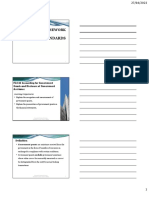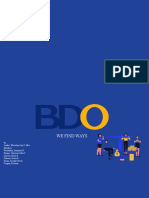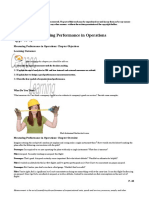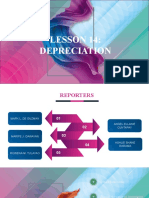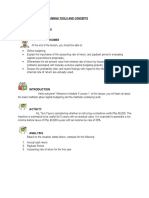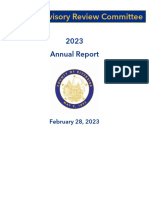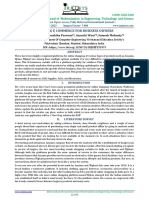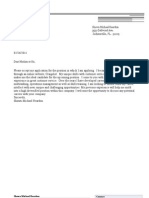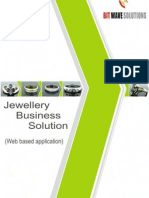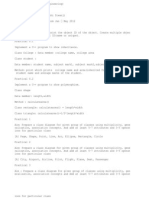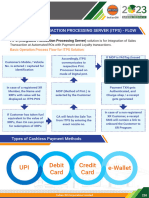Professional Documents
Culture Documents
Developing Online Shopping Application and Data Analysis
Developing Online Shopping Application and Data Analysis
Original Description:
Copyright
Available Formats
Share this document
Did you find this document useful?
Is this content inappropriate?
Report this DocumentCopyright:
Available Formats
Developing Online Shopping Application and Data Analysis
Developing Online Shopping Application and Data Analysis
Copyright:
Available Formats
Volume 8, Issue 5, May – 2023 International Journal of Innovative Science and Research Technology
ISSN No:-2456-2165
Developing Online Shopping Application and
Data Analysis
Sourav Saha1 Rahul Kumar Das2 Suman Modak3
ECE Department, JIS College of ECE Department, JIS College of ECE Department, JIS College of
Engineering, Kalyani Engineering, Kalyani Engineering, Kalyani
Suvarghya Banik Roy4 Subhadip Bhaumik5
ECE Department, JIS College of Engineering, Kalyani ECE Department, JIS College of Engineering, Kalyani
Dr. Indranath Sarkar6 Dr. Bikramjit Sarkar7
Professor Professor
ECE Department, JIS College of Engineering, Kalyani CSE Department, JIS College of Engineering, Kalyani
Abstract:- In this age of the internet, most of the things Keywords:- Web Application, Responsive Design, Frontend
that we have used to doing physically, now are and Backend Development, Data Analysis and Visualization.
automated and internet driven. Because of this revolution
one of the basic jobs like shopping, is getting done by web I. INTRODUCTION
applications. The people of this developed age are
making their day-to-day purchases using online Online shopping web applications have revolutionized
shopping apps. In this paper we have proposed a the way people shop. Online shopping web applications
shopping web application and analyzed various steps of have become increasingly popular over the years, with more
its development. It contains the entire procedure, which and more consumers turning to e-commerce for their
begins with determining the sections of our application. shopping needs. With the rise of e-commerce, consumers
Like here we have login page, catalog page, checkout or can shop for products and services from the comfort of their
payment page and admin control page, developing a own homes. This convenience has made online shopping a
responsive design for frontend and developing a backend popular choice among consumers worldwide [1].
for our application. In front-end Html, Css, Bootstrap
and JavaScript are used and in backend Servlets, JSP, Data analytics is the process of examining large and
SQL, Hibernate and Java programming language are complex data sets to extract valuable insights and
used, there is an extensive discussion about the information [2,3]. In the context of online shopping web
technologies that we have used for frontend and backend applications, data analytics can help businesses understand
development. Open-source data analysis and consumer behavior, preferences, and trends. This
visualization of online shopping apps like Flipkart and information can then be used to improve the shopping
Amazon are added. The analysis was done to check some experience for customers, increase sales, and drive business
information such as what are most selling products, the growth [4]. In recent years, the use of data analytics in
discount rates on these products and the seasonal most online shopping web applications has become a game-
selling products etc. This data will be helpful in changer in the e-commerce industry[5].
determining what are the products that should be kept
in stock for every season and the discount rates on them Objective of this paper is to develop an enriched e-
etc so that the user base can be increased. and we have commerce website in our country that can be largely
mentioned features which would make our web acceptable by the customers.
application unique in case of further development.
IJISRT23MAY2624 www.ijisrt.com 2671
Volume 8, Issue 5, May – 2023 International Journal of Innovative Science and Research Technology
ISSN No:-2456-2165
II. WEB APPLICATION DESIGN
Fig 1 Block Diagram of Proposed Web Application Design
Overall workflow of the shopping application The checkout page will display a summary of the
development has been presented in the flow chart (Fig. 1). items that the user has added to their cart. So, on the
The shopping web app has a Home page where users can checkout page, the user will need to enter their local address
start browsing products. To access the website's features, details for the delivery of the products. Once all the details
users need to register or log in. Once the user enters their have been entered, the user can proceed to the payment
login credentials, they can log in as a normal user or an gateway tocomplete the transaction.
admin user.
If the user logs in as an admin, they will have full
On successful login, the user's username will be control over the website's functionalities. The admin can see
displayed in the top right corner of the page. Additionally, the number of customers who have registered on the
there will be an option for users to log out when they want website, the number of products available on the website,
to exit the website. As a normal user, the user can browse and the number of categories under which the products are
through the various products that are available for purchase. listed. Additionally, the admin can add new products and
The products section will contain all the items that are categories to the website to expand the website's offerings.
available on the website. The user can select the product Both the normal user and admin user can log out of the
they want to buy and add it to their cart. Once the user has website at any time by clicking on the logout button.
added all the products they want to purchase, they can
proceed to the checkout page.
III. DATABASE STRUCTURE DESIGN
Fig 2 User Data
Fig 3 Data Category
IJISRT23MAY2624 www.ijisrt.com 2672
Volume 8, Issue 5, May – 2023 International Journal of Innovative Science and Research Technology
ISSN No:-2456-2165
Fig 4 Product Details
Fig. 2,3,4 shows the entities, attributes, and Products associated with it. For example, a smartphone
relationships between the different components of the web product can be associated with only one category, such as
application. "Electronics", but the "Electronics" category can have many
products associated with it, such as smartphones, laptops,
Entities: and headphones.
User: In the above image, this relationship is represented
The user entity stores information about the users of by a one-to-many relationship between the Category entity
the web application, including their name, email, password, (represented as the parent entity) and the Product entity
and address. (represented as the child entity). The Category entity has a
primary key attribute called "Category ID", which uniquely
Product: identifies each category, and the Product entity has a foreign
The product entity stores information about the key attribute called "Category ID" that refers to the Category
products available for purchase on the website, including entity's "Category ID" attribute. This indicates that each
their name, description, price, and image. Product is associated with only one Category. The
relationship is also indicated by the crow's foot notation on
Category: the Category side, which shows that each Category can have
The category entity stores information about the many Products associated with it.
different categories of products, such as electronics,
clothing, and home goods. Here are some technical terms that are commonly used
in the design and development of an online shopping
Relationships: web application:
Product and Category: E-R Diagram:
One Category, Many Products: This relationship means An Entity-Relationship diagram is a visual
that each Category can have many Products associated with representation of the data schema used in the web
it, but each Product can belong to only one Category. For application. It shows the different entities, attributes, and
example, the "Electronics" categorycan have many products relationships between them.
associated with it, such as smartphones, laptops, and
headphones, but each product can belong to only one User Authentication:
category, such as "Electronics". This refers to the process of verifying the identity of
the user trying to access the web application. The user is
Many Products, One Category: required to enter their login credentials, such as their email
This relationship means that each Product is associated and password, to gain access to the system.
with only one Category, but each Category can have many
IJISRT23MAY2624 www.ijisrt.com 2673
Volume 8, Issue 5, May – 2023 International Journal of Innovative Science and Research Technology
ISSN No:-2456-2165
User Authorization: Database Integration:
This refers to the process of determining the access To integrate GPS data in the web application, the
rights of the user once they have been authenticated. The location data of local shops can be stored in the database
system checks the user's access level and determines what along with other shop information such as shop name,
actions they are allowed to perform. address, phone number, and product availability.
Database: User Interface:
The database stores all the information related to the The user interface of the web application can be
web application, such as user data, product data, and designed to allow users to search for local shops based on
category data. their location. This can be done by adding a search bar or
map to the website where users can enter their location or
Backend: use their device's GPS to find nearbyshops.
The backend of the web application is responsible for
processing user requests and returning responses. It interacts Navigation:
with the database and other external systems to retrieve and Once the user has found a local shop that they want to
process data. visit, the web application can provide navigation directions
to guide the user to the shop.
Frontend:
The frontend of the web application is responsible for Mobile App Integration:
displaying the user interface to the user. It interacts with the To enhance the user experience, a mobile app can be
backend to retrieve and display data. developed that utilizes the GPS capabilities of the user's
device. This can provide more accurate location data and a
Shopping Cart: better user experience for userswho are on the go.
A shopping cart is a temporary storage area where the
user can store items that they wish topurchase. Integrating GPS for local shops in the online shopping
web application can greatly enhance the user experience and
Checkout: make it easier for users to find the products they are looking
The checkout process is the final step in the shopping for.
process. The user enters their payment and shipping
information and confirms their purchase. IV. SCOPE OF FUTURE EXPANSION
Payment Gateway: In the future, as online commerce continues to grow,
Online payments that are managed by a payment this website will offer users the option to register as either a
gateway service. It securely processes the user's payment buyer or a seller. The registration page will likely include a
information and authorizes thetransaction. brief explanation of the differences between the two options
so that users can make an informed decision about which
Session Management: role they want to play.
Session management is the process of managing the
user's session in the web application. It ensures that the user Those who choose to register as buyers will typically
remains logged in and that their session remains active until be able to browse through listings of products or services
they log out or their session expires. and make purchases directly from sellers. They may also
have the option to save items to a wishlist, leave reviews or
Including GPS for local shops in the online shopping ratings for sellers, or track the status of their orders.
web application can provide several benefits for users. By
integrating GPS location data, users can easily find local On the other hand, those who register as sellers will be
shops that carry the products they are looking for, which can able to create listings of their own products or services and
save them time and money on shipping costs. Here are some set prices or terms of sale. They may also be able to manage
technical terms related to integrating GPS data in an online their inventory, process orders, and communicate with
shopping web app: buyers directly through the website. Some platforms may
offer additional tools or resources for sellers, such as
Geolocation: analytics or marketing assistance, to help them optimize
Geolocation is the process of identifying the their sales.
geographic location of a user or device using GPS or other
location-based services. Equal Opportunity for Offline Vendors:
Due to the widespread popularity and accessibility of
API: e- commerce websites and applications, offline shop
An API (Application Programming Interface) is a set vendors are currently having trouble managing their
of protocols and tools for building software applications. In operations effectively and financially. Due to the fact that
the context of an online shopping web app, an API can be the majority of client traffic is now directed towards online
used to retrieve and display GPS data from external shopping applications, it is extremely difficult for them to
location-based services, such as Google Maps. compete with e-commerce websites.
IJISRT23MAY2624 www.ijisrt.com 2674
Volume 8, Issue 5, May – 2023 International Journal of Innovative Science and Research Technology
ISSN No:-2456-2165
Customers who shop online may encounter a variety this reason, offline store owners who want to boost the
of issues, like obtaining the incorrect item, defective goods, likelihood that their products will sell should put them
late delivery, challenges with replacements or refund online. One can access both online and offline shopping
processing, etc. For these reasons, some people prefer to with the use of this type of website, and offline vendors will
purchase their necessities from offline markets, but they are have an equal opportunity to grow their business.
unable to do so because they lack knowledge of the stores or
locations where they can do so. They ultimately decide to Businesses can open up new growth prospects, reach a
purchase it from online shops. larger market, and offer a smooth purchasing experience that
promotes consumer loyalty and pleasure by investing in the
In this e-commerce website, there will be an option creation of e-commerce websites. So, if you want to grow
from where the user can select their shopping preference your company, think about creating an e-commerce
(Online/offline). This interface allows users to select their website right now.
preferred shopping method by selecting either "Online" or
"Offline" option. Once the user selects their preferred REFERENCES
shopping method, they can click the "Next" button to
proceed with their shopping experience. This interface can [1]. Jill Mosteller, Naveen Donthu, Sevgin Eroglu.
be used in a variety of contexts, such as e-commerce Journal of Business Research. 67,2411-2423.(2014)
websites or mobile apps, physical retail stores, or hybrid [2]. Ruvalcaba, Z., & Boehm, A., “Introduction To The
shopping experiences. Web Development” in murach’s HTML5 and CSS3,
1sted., Fresno, CA: Mike Murach and Associates,
If the user selects online, the process will be the same Inc., 2012, pp. 4-7.
as other websites, but if selected offline, a new window will [3]. S. B. Gupta and A. Mittal, Introduction to Database
open where the user has to type the product name in the Managment System, New Delhi: University of
search box. Then, as a result, it will show the nearby shops Science Press, 2017.
from where the user can get it. It will also display the [4]. Javier Pérez-Hernández, Rocío Sánchez-Mangas.
product price and the rating of the product in different shops. Information Economics and Policy. 23, 202-
Now, the user can compare the price and the rating and 213(2011).
choose the particular shop from where he/she wants to buy it. [5]. Farag, S., Krizek, K. J., & Dijst, M. (2006). E‐
The interface could also display additional information Shopping and its Relationship with In‐store
about each shop, such as its name, address, phone number, Shopping: Empirical Evidence from the Netherlands
hours of operation, and customer ratings or reviews. Users and the USA. Transport Reviews, 26(1), 43–61.
could click on a marker to see this information in a pop-up doi:10.1080/01441640500158496
window or sidebar. [6]. International Journal of Advanced Computer
Research (ISSN (print): 2249-7277 ISSN (online):
In addition to displaying nearby shops, the interface 2277-7970) Volume-4 Number-1 Issue-14 March-
could also provide other features, such as the ability to get 2014
directions to a shop, save favorite shops for future reference, [7]. CIKM '17: Proceedings of the 2017 ACM on
or share shop locations with friends. Conference on Information and Knowledge
ManagementNovember 2017Pages 1299–
After selecting the shop, it will now show the 1308https://doi.org/10.1145/3132847.3132954
distance between the user and the selected shop. By using
GPS tracker, the user can get the route in order to reach the
shop. Overall, the interface should be user-friendly, visually
appealing, and provide the information that users need to
findnearby shops quickly and easily.
V. CONCLUSION
In conclusion, creating an e-commerce website is a
crucial first step for any company seeking to grow its
clientele and boost sales online. When building an e-
commerce website, several elements must be carefully taken
into account, including the platform selection, the site's
design and layout, the security precautions taken, and the
features and functionality necessary to deliver the best user
experience.
Businesses that don't create an e-commerce website
run the danger of falling behind their rivals and missing out
on important chances to engage with customers and make
money given the rising popularity of online shopping. For
IJISRT23MAY2624 www.ijisrt.com 2675
You might also like
- Pas 20Document4 pagesPas 20AnneNo ratings yet
- CFAS PPT 26 - PAS 41 (Agriculture)Document26 pagesCFAS PPT 26 - PAS 41 (Agriculture)Asheh DinsuatNo ratings yet
- Manila Cavite Laguna Cebu Cagayan de Oro DavaoDocument6 pagesManila Cavite Laguna Cebu Cagayan de Oro DavaoMonica GarciaNo ratings yet
- Cfas 2019 Ch.08 and Ch.09 Long Problems SolutionsDocument15 pagesCfas 2019 Ch.08 and Ch.09 Long Problems SolutionsNathalie GetinoNo ratings yet
- Restaurant Management SystemDocument4 pagesRestaurant Management Systemchau777100% (1)
- CO12101E IP08 ProblemDocument6 pagesCO12101E IP08 ProblemHaydee0% (1)
- Retail Organization StructureDocument12 pagesRetail Organization Structurewatway_as81% (16)
- Bdo PresentationDocument28 pagesBdo PresentationTen Balestramon100% (1)
- Intermediate Accounting 2 Reviewer PDFDocument133 pagesIntermediate Accounting 2 Reviewer PDFCarl CagampzNo ratings yet
- Chapter 1,2,3 (Shanne)Document15 pagesChapter 1,2,3 (Shanne)vanrudolph94% (48)
- Activity Template Project Plan Sauce and SpoonDocument47 pagesActivity Template Project Plan Sauce and SpoonAlex BuiNo ratings yet
- Ariba Supplier Mobile App Quick Start Guide 2Document20 pagesAriba Supplier Mobile App Quick Start Guide 2William CorrêaNo ratings yet
- AFAR 1.5 - Construction ContractsDocument3 pagesAFAR 1.5 - Construction ContractsKile Rien MonsadaNo ratings yet
- Local StudiesDocument5 pagesLocal StudiesJohn Mark CleofasNo ratings yet
- Chapter 29-Biological Assets: Question 29-1Document21 pagesChapter 29-Biological Assets: Question 29-1Cyrus IsanaNo ratings yet
- FM 101 Chapter 2 (Cabrera)Document17 pagesFM 101 Chapter 2 (Cabrera)Chelsea PagcaliwaganNo ratings yet
- Job Order Costing CH 5 - 1Document31 pagesJob Order Costing CH 5 - 1Hammad ArifNo ratings yet
- Cost Chap 1Document24 pagesCost Chap 1Peter Paul DeiparineNo ratings yet
- Republic of The PhilippinesDocument49 pagesRepublic of The PhilippinesJohn Kenneth ContrerasNo ratings yet
- Chapter 3Document20 pagesChapter 3abebe kumelaNo ratings yet
- Class Work & Home Work Question of Final Account of Banking Conpany 22-23Document23 pagesClass Work & Home Work Question of Final Account of Banking Conpany 22-23DARK KING GamersNo ratings yet
- Dividend QuestionDocument43 pagesDividend QuestionRehaan ShahNo ratings yet
- FM Testbank Ch13Document29 pagesFM Testbank Ch13David LarryNo ratings yet
- Manual Solution 6-14Document5 pagesManual Solution 6-14Sohmono HendraiosNo ratings yet
- Chapter 12 - Measuring Performance in OperationsDocument23 pagesChapter 12 - Measuring Performance in OperationsHAN LIEU GIANo ratings yet
- Lesson 14: DepreciationDocument36 pagesLesson 14: DepreciationMark Lacaste De GuzmanNo ratings yet
- Ethic CHPT 3Document31 pagesEthic CHPT 3Michaela SchmidtNo ratings yet
- CFAS ReviewerDocument21 pagesCFAS ReviewerHANNA KADIJA ABBASNo ratings yet
- PHINMA Examination ACC 107 Intermediate Accounting 2Document18 pagesPHINMA Examination ACC 107 Intermediate Accounting 2Un knownNo ratings yet
- Corporate Income TaxDocument24 pagesCorporate Income TaxRIRI RUMAIZHANo ratings yet
- Module 6 Part 1 Internal ControlDocument21 pagesModule 6 Part 1 Internal ControlHailsey WinterNo ratings yet
- General Mercantile Agency: Credit Bureau Public Company Short Hills Millburn Business-To-BusinessDocument2 pagesGeneral Mercantile Agency: Credit Bureau Public Company Short Hills Millburn Business-To-BusinessSteph BorinagaNo ratings yet
- 01 Notes NPO WA For HasanDocument86 pages01 Notes NPO WA For HasanHassan MasoodNo ratings yet
- Financial Statements: General Purpose FS: For Users Not in The Position ToDocument3 pagesFinancial Statements: General Purpose FS: For Users Not in The Position ToRoyce DenolanNo ratings yet
- Economic Development Chapter 1-3Document6 pagesEconomic Development Chapter 1-3Assault ProNo ratings yet
- Past Papers YEAR 3 PDFDocument172 pagesPast Papers YEAR 3 PDFraina mattNo ratings yet
- CAB AcctDocument9 pagesCAB AcctA.J. ChuaNo ratings yet
- Week 6-7 Info Sheets - Financial Planning Tools and ConceptsDocument21 pagesWeek 6-7 Info Sheets - Financial Planning Tools and ConceptsCK BarretoNo ratings yet
- Chapter Five 5. Investment IncentivesDocument12 pagesChapter Five 5. Investment IncentivesSeid KassawNo ratings yet
- Auditing Theories and Problems Quiz WEEK 1Document19 pagesAuditing Theories and Problems Quiz WEEK 1Sarah GNo ratings yet
- Shahid HussainDocument16 pagesShahid HussainShahzaib Hussain100% (1)
- Chapter 7 Problem 7Document3 pagesChapter 7 Problem 7Pamela PerezNo ratings yet
- SQ CS of Puregold BalibagoDocument64 pagesSQ CS of Puregold BalibagoEmy Rose N. DiosanaNo ratings yet
- BTF3601 ExamDocument8 pagesBTF3601 ExamOverflagNo ratings yet
- Chapter 14 ECON NOTESDocument12 pagesChapter 14 ECON NOTESMarkNo ratings yet
- Assessment of The Level of Financial Literacy Among Microentrepreneurs in Relation To Their Business GrowthDocument74 pagesAssessment of The Level of Financial Literacy Among Microentrepreneurs in Relation To Their Business Growthjovina dimacaleNo ratings yet
- IDBI Federal Childsurance Saving - Policy Schedule - 2013-14Document9 pagesIDBI Federal Childsurance Saving - Policy Schedule - 2013-14Shankar Suman SinghNo ratings yet
- 2023 Riverside County Pension Advisory Review Committee ReportDocument24 pages2023 Riverside County Pension Advisory Review Committee ReportThe Press-Enterprise / pressenterprise.comNo ratings yet
- Problems On Balance SheetDocument4 pagesProblems On Balance SheetNishant DehuryNo ratings yet
- PRELEC1 Exercise Worksheet Unit 01Document3 pagesPRELEC1 Exercise Worksheet Unit 01Ann Diane Renz DongsalNo ratings yet
- Conceptual Framework and Accounting Standards - Chapter 4 - NotesDocument4 pagesConceptual Framework and Accounting Standards - Chapter 4 - NotesKhey KheyNo ratings yet
- VontDocument128 pagesVontch tcNo ratings yet
- Is TEST Y2 SME ABC Physcis Marking GuideDocument5 pagesIs TEST Y2 SME ABC Physcis Marking GuideMichel UTAZIRUBANDANo ratings yet
- Corporate Accounting - II (Solutions)Document107 pagesCorporate Accounting - II (Solutions)Leo JacobNo ratings yet
- Megawide Construction Corporation - Reviewed 2Q 2021 FS - 2021 09 02Document102 pagesMegawide Construction Corporation - Reviewed 2Q 2021 FS - 2021 09 02PaulNo ratings yet
- Intangible AssetsDocument87 pagesIntangible AssetsNoor fatimaNo ratings yet
- Accounting BookDocument95 pagesAccounting BookHermixoneNo ratings yet
- CH - 3 - Interest Rates and Security Valuation - PPTDocument52 pagesCH - 3 - Interest Rates and Security Valuation - PPTApra khediNo ratings yet
- Intership Report FinalDocument34 pagesIntership Report Final720721206028 MADHESH DNo ratings yet
- Module #18Document7 pagesModule #18Joy RadaNo ratings yet
- 11Document3 pages11Mohamed HassanNo ratings yet
- 4.5 Types of Products of IFB in DBDocument11 pages4.5 Types of Products of IFB in DBSamson DamtewNo ratings yet
- FCCB (Assignment)Document10 pagesFCCB (Assignment)loveaute15No ratings yet
- MAC 406 Performance Management SystemsDocument38 pagesMAC 406 Performance Management SystemsRhodemar CuartoNo ratings yet
- Tackling E Commerce For Business Owners: Kush Agarwal, Vanshika Peswani, Aayushi Wani, Sumesh MohantyDocument5 pagesTackling E Commerce For Business Owners: Kush Agarwal, Vanshika Peswani, Aayushi Wani, Sumesh MohantySujith AdabalaNo ratings yet
- Exploring the Potential Advantages of Traditional Therapies in Autoimmune Blistering Illnesses: A Comprehensive Review and Analysis, ResearchDocument12 pagesExploring the Potential Advantages of Traditional Therapies in Autoimmune Blistering Illnesses: A Comprehensive Review and Analysis, ResearchInternational Journal of Innovative Science and Research TechnologyNo ratings yet
- Seasonal Variation and Distribution Patterns of Endophytic Community in Withania somniferaDocument7 pagesSeasonal Variation and Distribution Patterns of Endophytic Community in Withania somniferaInternational Journal of Innovative Science and Research TechnologyNo ratings yet
- Unlocking Sentiments: Enhancing IOCL Petrol Pump ExperiencesDocument8 pagesUnlocking Sentiments: Enhancing IOCL Petrol Pump ExperiencesInternational Journal of Innovative Science and Research TechnologyNo ratings yet
- Skin Disease Detection and Remedial SystemDocument7 pagesSkin Disease Detection and Remedial SystemInternational Journal of Innovative Science and Research TechnologyNo ratings yet
- Development of Smart Ground Fault Location Model for Radial Distribution SystemDocument14 pagesDevelopment of Smart Ground Fault Location Model for Radial Distribution SystemInternational Journal of Innovative Science and Research TechnologyNo ratings yet
- Design and Development of Multi-Featured Medical StretcherDocument4 pagesDesign and Development of Multi-Featured Medical StretcherInternational Journal of Innovative Science and Research TechnologyNo ratings yet
- EmoConnect: Nurturing Trust and Relationship Bonds in Alzheimer’s ConversationsDocument3 pagesEmoConnect: Nurturing Trust and Relationship Bonds in Alzheimer’s ConversationsInternational Journal of Innovative Science and Research TechnologyNo ratings yet
- Smart and Secure Home with ChatbotDocument9 pagesSmart and Secure Home with ChatbotInternational Journal of Innovative Science and Research TechnologyNo ratings yet
- Firm Size as a Mediator between Inventory Management Andperformance of Nigerian CompaniesDocument8 pagesFirm Size as a Mediator between Inventory Management Andperformance of Nigerian CompaniesInternational Journal of Innovative Science and Research TechnologyNo ratings yet
- Reading Intervention Through “Brigada Sa Pagbasa”: Viewpoint of Primary Grade TeachersDocument3 pagesReading Intervention Through “Brigada Sa Pagbasa”: Viewpoint of Primary Grade TeachersInternational Journal of Innovative Science and Research TechnologyNo ratings yet
- Application of Plant Growth Promoting Rhizobacteria on Vegetative Growth in Chili Plants (Capsicum frutescens L.)Document7 pagesApplication of Plant Growth Promoting Rhizobacteria on Vegetative Growth in Chili Plants (Capsicum frutescens L.)International Journal of Innovative Science and Research TechnologyNo ratings yet
- Preparation and Identification of Magnetic Iron Nanoparticle based on a Natural Hydrogel and its Performance in Targeted Drug DeliveryDocument17 pagesPreparation and Identification of Magnetic Iron Nanoparticle based on a Natural Hydrogel and its Performance in Targeted Drug DeliveryInternational Journal of Innovative Science and Research TechnologyNo ratings yet
- A Study to Assess the Knowledge Regarding Teratogens Among the Husbands of Antenatal Mother Visiting Obstetrics and Gynecology OPD of Sharda Hospital, Greater Noida, UpDocument5 pagesA Study to Assess the Knowledge Regarding Teratogens Among the Husbands of Antenatal Mother Visiting Obstetrics and Gynecology OPD of Sharda Hospital, Greater Noida, UpInternational Journal of Innovative Science and Research TechnologyNo ratings yet
- Application of Game Theory in Solving Urban Water Challenges in Ibadan-North Local Government Area, Oyo State, NigeriaDocument9 pagesApplication of Game Theory in Solving Urban Water Challenges in Ibadan-North Local Government Area, Oyo State, NigeriaInternational Journal of Innovative Science and Research TechnologyNo ratings yet
- On the Development of a Threat Driven Model for Campus NetworkDocument14 pagesOn the Development of a Threat Driven Model for Campus NetworkInternational Journal of Innovative Science and Research TechnologyNo ratings yet
- Global Warming Reduction Proposal AssessmentDocument6 pagesGlobal Warming Reduction Proposal AssessmentInternational Journal of Innovative Science and Research TechnologyNo ratings yet
- Exploring the Post-Annealing Influence on Stannous Oxide Thin Films via Chemical Bath Deposition Technique: Unveiling Structural, Optical, and Electrical DynamicsDocument7 pagesExploring the Post-Annealing Influence on Stannous Oxide Thin Films via Chemical Bath Deposition Technique: Unveiling Structural, Optical, and Electrical DynamicsInternational Journal of Innovative Science and Research TechnologyNo ratings yet
- PHREEQ C Modelling Tool Application to Determine the Effect of Anions on Speciation of Selected Metals in Water Systems within Kajiado North Constituency in KenyaDocument71 pagesPHREEQ C Modelling Tool Application to Determine the Effect of Anions on Speciation of Selected Metals in Water Systems within Kajiado North Constituency in KenyaInternational Journal of Innovative Science and Research TechnologyNo ratings yet
- Detection of Phishing WebsitesDocument6 pagesDetection of Phishing WebsitesInternational Journal of Innovative Science and Research TechnologyNo ratings yet
- Mandibular Mass Revealing Vesicular Thyroid Carcinoma A Case ReportDocument5 pagesMandibular Mass Revealing Vesicular Thyroid Carcinoma A Case ReportInternational Journal of Innovative Science and Research TechnologyNo ratings yet
- Sustainable Energy Consumption Analysis through Data Driven InsightsDocument16 pagesSustainable Energy Consumption Analysis through Data Driven InsightsInternational Journal of Innovative Science and Research TechnologyNo ratings yet
- Realigning Curriculum to Simplify the Challenges of Multi-Graded Teaching in Government Schools of KarnatakaDocument5 pagesRealigning Curriculum to Simplify the Challenges of Multi-Graded Teaching in Government Schools of KarnatakaInternational Journal of Innovative Science and Research TechnologyNo ratings yet
- Vertical Farming System Based on IoTDocument6 pagesVertical Farming System Based on IoTInternational Journal of Innovative Science and Research TechnologyNo ratings yet
- Consistent Robust Analytical Approach for Outlier Detection in Multivariate Data using Isolation Forest and Local Outlier FactorDocument5 pagesConsistent Robust Analytical Approach for Outlier Detection in Multivariate Data using Isolation Forest and Local Outlier FactorInternational Journal of Innovative Science and Research TechnologyNo ratings yet
- Esophageal Melanoma - A Rare NeoplasmDocument3 pagesEsophageal Melanoma - A Rare NeoplasmInternational Journal of Innovative Science and Research TechnologyNo ratings yet
- The Impact of Music on Orchid plants Growth in Polyhouse EnvironmentsDocument5 pagesThe Impact of Music on Orchid plants Growth in Polyhouse EnvironmentsInternational Journal of Innovative Science and Research Technology100% (1)
- Review on Childhood Obesity: Discussing Effects of Gestational Age at Birth and Spotting Association of Postterm Birth with Childhood ObesityDocument10 pagesReview on Childhood Obesity: Discussing Effects of Gestational Age at Birth and Spotting Association of Postterm Birth with Childhood ObesityInternational Journal of Innovative Science and Research TechnologyNo ratings yet
- Osho Dynamic Meditation; Improved Stress Reduction in Farmer Determine by using Serum Cortisol and EEG (A Qualitative Study Review)Document8 pagesOsho Dynamic Meditation; Improved Stress Reduction in Farmer Determine by using Serum Cortisol and EEG (A Qualitative Study Review)International Journal of Innovative Science and Research TechnologyNo ratings yet
- Investigating Non-Newtonian Fluid Behavior in Hydrocyclones Via Computational Fluid DynamicsDocument18 pagesInvestigating Non-Newtonian Fluid Behavior in Hydrocyclones Via Computational Fluid DynamicsInternational Journal of Innovative Science and Research TechnologyNo ratings yet
- Influence of Principals’ Promotion of Professional Development of Teachers on Learners’ Academic Performance in Kenya Certificate of Secondary Education in Kisii County, KenyaDocument13 pagesInfluence of Principals’ Promotion of Professional Development of Teachers on Learners’ Academic Performance in Kenya Certificate of Secondary Education in Kisii County, KenyaInternational Journal of Innovative Science and Research Technology100% (1)
- Hoosier Burger Case PDFDocument12 pagesHoosier Burger Case PDFMohammed ABDO ALBAOMNo ratings yet
- Resume Revise CombinedDocument3 pagesResume Revise CombinedShawn-michael ReardonNo ratings yet
- 5890 X ManualDocument8 pages5890 X ManualZener Garcia CedroNo ratings yet
- Final Exam - Dba Strategic Management ExamDocument44 pagesFinal Exam - Dba Strategic Management ExamRozhanNo ratings yet
- Property Management System and Point of Sale SystemDocument13 pagesProperty Management System and Point of Sale SystemHayllieNo ratings yet
- Assessment Submission Sheet: Educating For ExcellenceDocument15 pagesAssessment Submission Sheet: Educating For ExcellenceChathuka PereraNo ratings yet
- 03092019060159lgs6cb45qwr8f7peim Estatement 082019 1727Document3 pages03092019060159lgs6cb45qwr8f7peim Estatement 082019 1727Nischal maharjanNo ratings yet
- Epos RetailerDocument11 pagesEpos RetailerBalpreet SinghNo ratings yet
- Manual EHCA 555-556 Rev - 01-08-2012Document60 pagesManual EHCA 555-556 Rev - 01-08-2012Zoran Bogićević RakunNo ratings yet
- Retail PlaybookDocument4 pagesRetail Playbooksiddig adamNo ratings yet
- Executive Summary: Plan OutlineDocument58 pagesExecutive Summary: Plan Outlineazeem bhattiNo ratings yet
- VMT5010 en V3.1Document33 pagesVMT5010 en V3.1Abdul_SamadNo ratings yet
- HYPERLINKDocument53 pagesHYPERLINKJaysa RamosNo ratings yet
- Sales Monitoring 04a v5 0Document98 pagesSales Monitoring 04a v5 0api-259005844No ratings yet
- Jewellery Business Solution: SolutionsDocument5 pagesJewellery Business Solution: SolutionsmehtavikalpNo ratings yet
- SIEMENS ELASA by Oscar Del SantoDocument3 pagesSIEMENS ELASA by Oscar Del SantoOscar César Del Santo, PhDNo ratings yet
- Dialock PDFDocument60 pagesDialock PDFK RameshNo ratings yet
- Pos Touch Screen-AerPOSLite-ταμειακό σύστημαDocument2 pagesPos Touch Screen-AerPOSLite-ταμειακό σύστημαWITEC_GREECENo ratings yet
- BIS GroupDocument5 pagesBIS GroupWena MusthafaNo ratings yet
- Magento Full Features List 052714 PDFDocument10 pagesMagento Full Features List 052714 PDFSheryl CoronelNo ratings yet
- Oodm PracticalsDocument5 pagesOodm PracticalsRoma ChaudharyNo ratings yet
- VisaNet Network Processing OverviewDocument16 pagesVisaNet Network Processing Overviewsalesuse2shopNo ratings yet
- Dealer Handbook Part 2 300523Document109 pagesDealer Handbook Part 2 300523SGM CONo ratings yet
- Black Purple Futuristic Mobile App Pricing Plan Presentation TemplateDocument10 pagesBlack Purple Futuristic Mobile App Pricing Plan Presentation TemplateThe ReaderNo ratings yet
- NOI Netcool Annou - LetterDocument30 pagesNOI Netcool Annou - LetterFer-Nando AlvarezNo ratings yet
